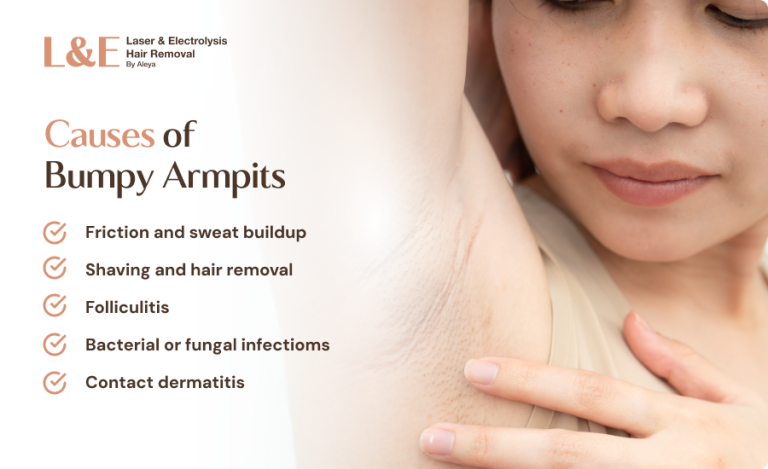Electrolysis vs. Laser Hair Removal: What’s the Difference?
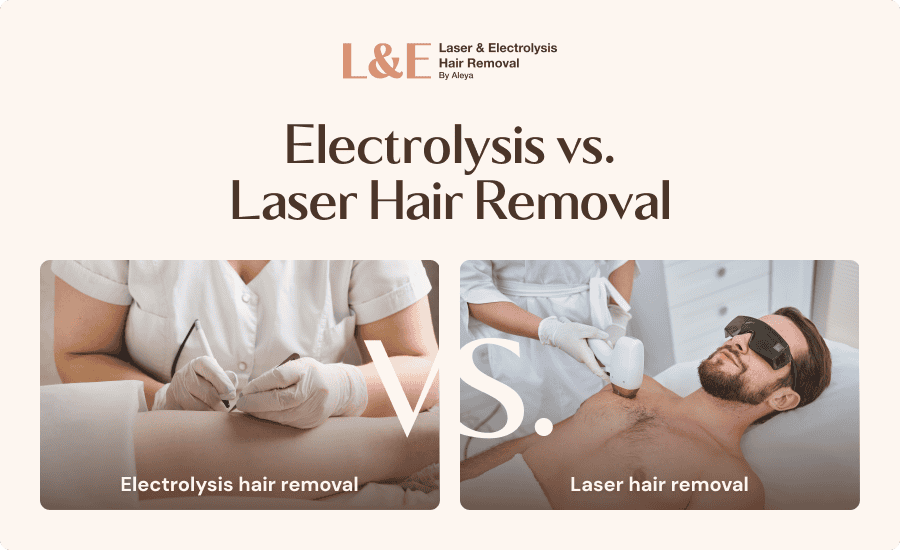
Electrolysis vs. Laser Hair Removal: Key Takeaways
- Electrolysis delivers permanent results, while laser significantly reduces hair growth over time
- The right choice depends on your hair color, skin tone, and goals
- Aleya specializes in both laser and electrolysis
The hair removal game is booming and is set to hit $4 billion as of 2025.
So, what does this mean? Well, people are ready to ditch razors for results that actually last.
But with so many hair removal options out there, choosing the right one can feel a little overwhelming.
Do you go with laser hair removal? Try electrolysis?
The truth is there’s no one-size-fits-all solution.
What works best really depends on your hair type, skin tone, and your schedule.
We put this guide together to give you straightforward, expert-backed answers to the questions that matter most, like:
- How does each method actually work and what can you expect to pay?
- How permanent are the results?
- How many sessions are needed before you get results
How Does Each Method Work?
Electrolysis takes a more precise approach.
A super fine probe is inserted into each individual hair follicle, delivering a tiny pulse of electrical current directly to the root.
This current destroys the follicle’s ability to grow new hair.
Since each hair is treated one at a time, electrolysis is especially effective for smaller areas like the face, brow, or chin.
Laser hair removal, on the other hand, uses concentrated light energy to target the pigment (melanin) in your hair.
This light, when converted to heat, travels down the hair shaft and damages the follicle.
Because it treats multiple hairs at once, laser is ideal for covering larger areas like the legs, arms, or back quickly and efficiently.
How Permanent Are the Results?
Electrolysis is currently the only FDA-approved method for permanent hair removal.
Because each individual hair follicle is destroyed with electrical current, the treated hair will not grow back.
Over time and with consistency, electrolysis delivers results that truly last a lifetime.
Laser hair removal offers long-term hair reduction, but it’s not truly permanent.
You can expect a significant decrease in hair growth, especially after six to eight sessions.
However, hormonal shifts or genetic factors can trigger regrowth over time.
That’s why occasional maintenance sessions are often recommended.
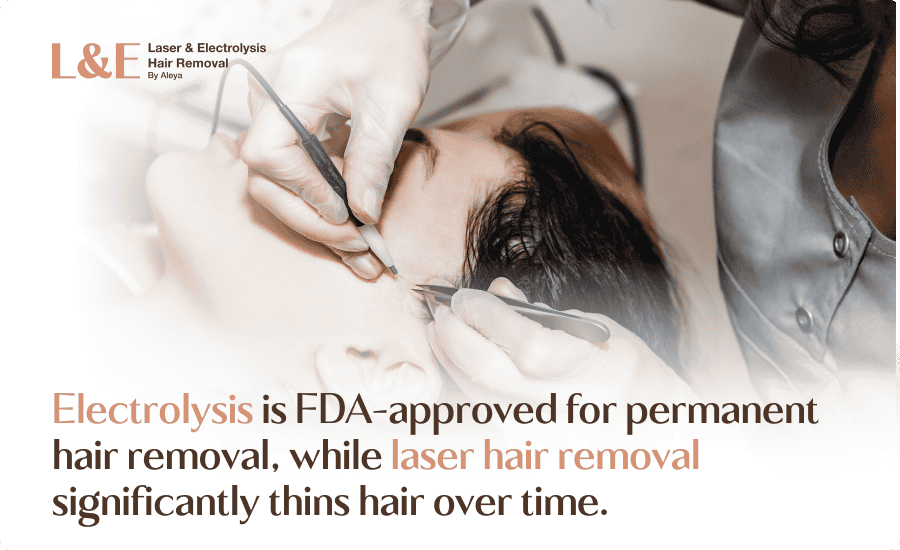
How Much Does It Cost?
When it comes to laser hair removal, pricing can vary quite a bit depending on where you go, what area you’re treating, and the type of laser being used.
At Laser by Aleya, prices vary depending on the treatment area. Here’s the full breakdown:
| Treatment Area | Price |
| Upper Lip | $30 |
| Half Face | $60 |
| Full Face | $120 |
| Underarms | $55 |
| Full Arms | $175 |
| Half Arms | $90 |
| Full Legs | $175 |
| Half Legs | $100 |
| Full Back | $100 |
| Half Back | $60 |
| Full Chest | $100 |
| Happy Trail | $45 |
| Backside (for women) | $100 |
| Brazilian (for women) | $75 |
| Bikini (for women) | $55 |
| Full Body | $500 |
And yes, students get great deals, too!
Next, let’s look at electrolysis.
Electrolysis is priced a bit differently than laser.
Rather than charging per body area, most clinics, including ours, set prices based on the time you spend in the chair.
Since it’s a hands-on, detailed process that treats each hair one by one, clinics have relied on a time-based model for years.
Here’s what you can expect to pay:
| Session Length | Price |
| 10-minute session | $25 |
| 15-minute session | $30 |
| 30-minute session | $50 |
| 45-minute session | $60 |
| 60-minute session | $80 |
What Kind of Tech Is Behind Each Method?
For electrolysis treatments, we use the Apilus XCell, one of the most advanced electrolysis systems in the world.
Operating at 27.12 MHz, up to six times faster than standard devices, it targets energy directly at the follicle base for faster, more effective results on all hair types.
Treatments are so fast, most clients barely feel a thing!
For laser hair removal, Aleya uses the Lumenis Diode LightSheer, a trusted medical-grade device known for its speed, precision, and effectiveness across a wide range of skin tones.
How Long Does Each Treatment Take?
Electrolysis takes more time because it targets each hair individually.
This precision makes it incredibly effective, but also more time-consuming.
For clients with thicker or denser hair growth (especially those of Middle Eastern, Greek, Italian, or Indian backgrounds), sessions might take longer and require more appointments.
Laser sessions are generally quick, especially when treating large areas.
Depending on the size of the area, you could be in and out in just 10 minutes or up to an hour for full legs or your back.
Since the laser targets multiple hairs at once, it’s a great option if you’re looking to treat a larger area in less time.
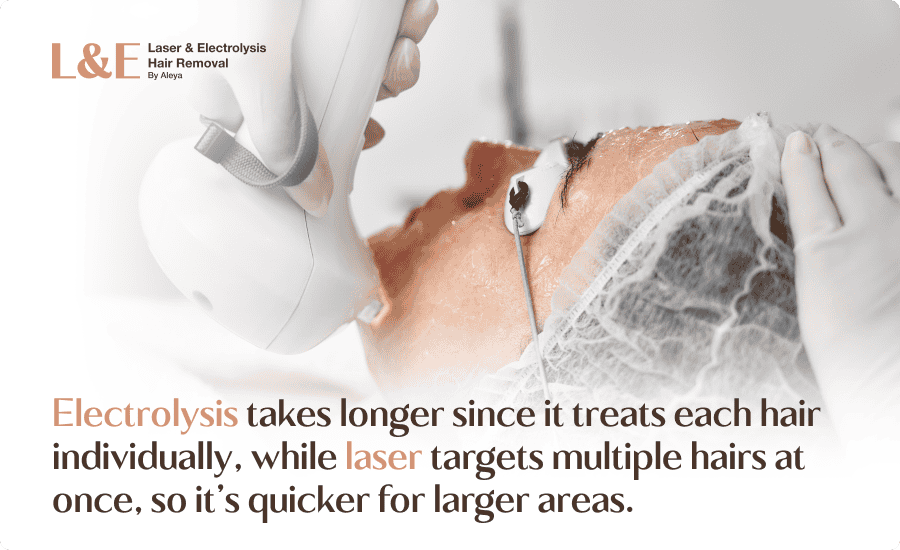
How Many Treatments Will You Need for Each Method?
Electrolysis is highly effective, but it’s not a one-and-done treatment.
In the beginning, most people come in once a week or every other week to stay ahead of new growth.
Since it targets each hair individually, the total number of sessions can vary quite a bit.
Factors like your hair density, hormonal health, and past hair removal methods (like waxing or tweezing) all play a role.
For laser hair removal, most people begin seeing visible results after six to nine sessions, spaced several weeks apart.
What Areas Can Be Treated?
Laser targets and removes unwanted hair from most areas of the body.
You can laser just about anywhere, legs, underarms, even toes (yep, we’ve done that!)
It’s especially popular for larger areas since it can cover a lot of ground quickly.
Electrolysis can treat all the same areas.
Since it targets individual hairs, it’s safe and precise enough for even the most delicate spots like the upper lip, chin, sideburns, and even eyebrows.
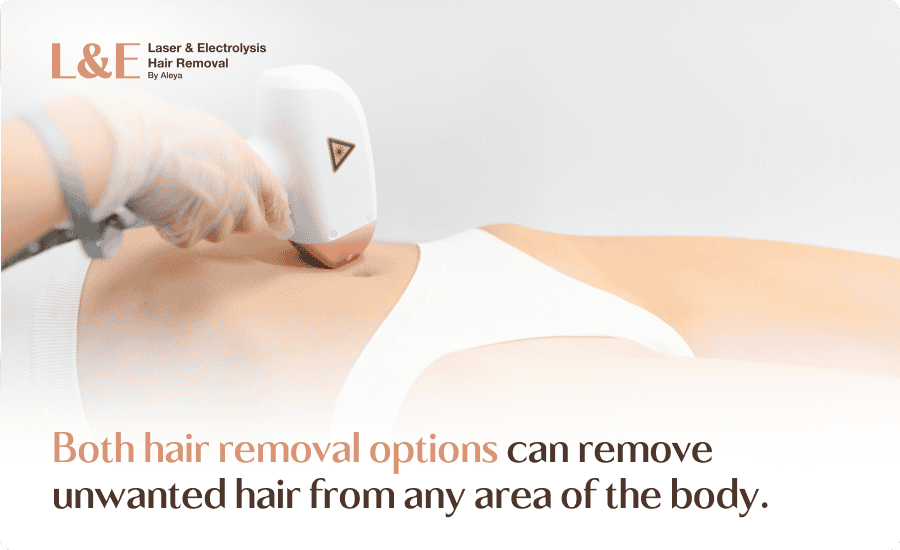
Which Hair Colors Do These Methods Work Best On?
Lasers work best on dark, coarse hair and light skin, where there’s enough contrast for the laser to target the pigment effectively.
If you have darker skin, advanced lasers like the Diode can still work well, but results depend on the device and your provider’s expertise.
The only limitation?
Laser hair removal is less effective on red, gray, white, or blonde hair because there isn’t enough pigment for the laser to target.
Electrolysis doesn’t rely on pigment at all, which is why it works on every hair color.
It also handles all textures, from super fine peach fuzz to thick, wiry hairs.
So, if you’ve been told laser won’t work for you because of your hair color, electrolysis is likely your best bet for permanent results.
How Painful Is Each Method?
Laser hair removal is often described as a rubber band snap, quick and over before you know it.
Discomfort is usually minimal, and for sensitive areas or lower pain tolerance, you can ask your technician about using a numbing cream.
Electrolysis often feels like a quick sting, pinch, or flash of heat.
It can be slightly more uncomfortable than laser since it treats each follicle individually.
But pain varies, and with proper prep, it’s very manageable, especially if you’re aiming for permanent results!
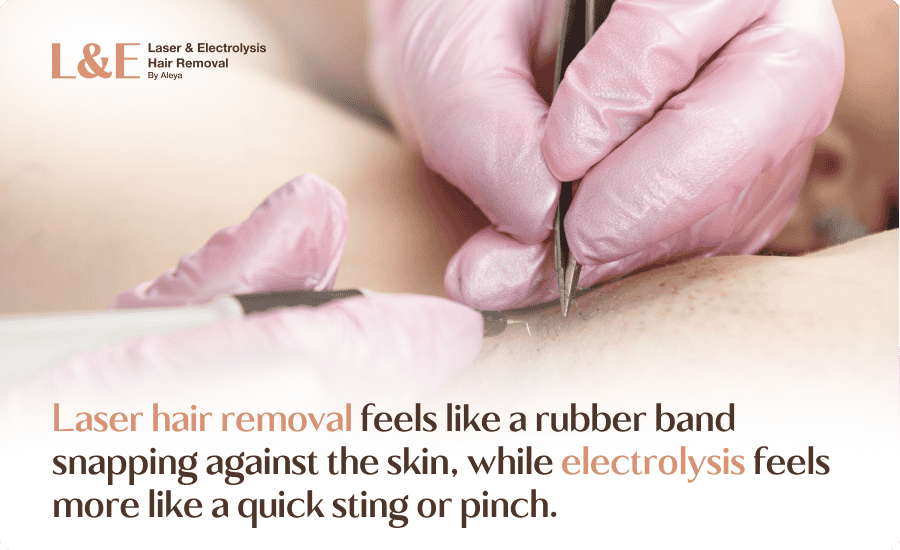
When Should You Consider Electrolysis Hair Removal?
- You’re looking for a truly permanent solution, as electrolysis is the only FDA-approved method for permanent hair removal.
- You have red, blonde, gray, or white hair.
- You’re targeting small or sensitive areas. Electrolysis is ideal for precision work on places like the upper lip, chin, eyebrows, or fingers.
- You’ve already tried laser but still have stubborn hairs. Electrolysis is great for cleaning up, especially in tricky, hormonal zones like the chin or jawline.
- You have a mix of hair types. Whether your hair is thick and coarse or fine and light, electrolysis can treat it effectively.
- You’re dealing with hormonal hair growth. If you have PCOS, menopause-related hair, or other hormone-driven changes, electrolysis is a reliable option.
- You’ve been told laser isn’t right for your skin tone or hair type.
When Should You Consider Laser Hair Removal?
- You want to significantly reduce hair growth long-term. Laser isn’t permanent, but it can drastically slow regrowth and thin out hair over time.
- You’re treating larger areas like your legs, arms, back, or chest. Laser covers more surface area quickly, making it ideal for full-body treatments.
- You have dark hair and light to medium skin. This combination responds best to laser because the pigment in the hair absorbs the light effectively.
- You want faster sessions. Most treatments take just 15 to 30 minutes, depending on the area.
- You’re okay with occasional maintenance. While results are long-lasting, most people need touch-ups once or twice a year to stay smooth.
- You’re not an ideal candidate for electrolysis or prefer less frequent visits. Laser requires fewer sessions overall, especially for large areas.
Ready to Try Laser or Electrolysis? Aleya Can Help You Decide
If you’re feeling unsure about which method is best for your skin or hair type, Aleya is here to help you figure it out.
At Laser by Aleya, we specialize in both laser hair removal and electrolysis, so we’re able to give you honest, informed guidance based on what will work for you.
We’ll take the time to assess your hair color, skin tone, treatment goals, and sensitivity preferences, then walk you through a customized plan that feels right for your body and your budget.
Whether you’re looking for fast, full-body results or a permanent fix for those stubborn facial hairs, we’ll help you feel confident every step of the way.
Laser Hair Removal vs. Electrolysis: FAQs
Can laser and electrolysis hair removal be done at the same time?
No, you shouldn’t do laser and electrolysis on the same area at the same time.
However, once you’ve completed your laser sessions, electrolysis can be a great way to clear any remaining or stubborn hairs that laser didn’t fully remove.
To safely combine both treatments, it’s best to consult with a laser specialist who can create a personalized plan based on your hair type, skin tone, and goals.
Will combining laser and electrolysis make hair removal faster?
Yes. When timed right, combining both can speed up results, especially for areas with mixed hair types.
Does electrolysis hurt more than laser?
Electrolysis might feel more intense, especially on sensitive areas like the upper lip or chin.
But keep in mind that it really depends on your pain tolerance and the area being treated.


